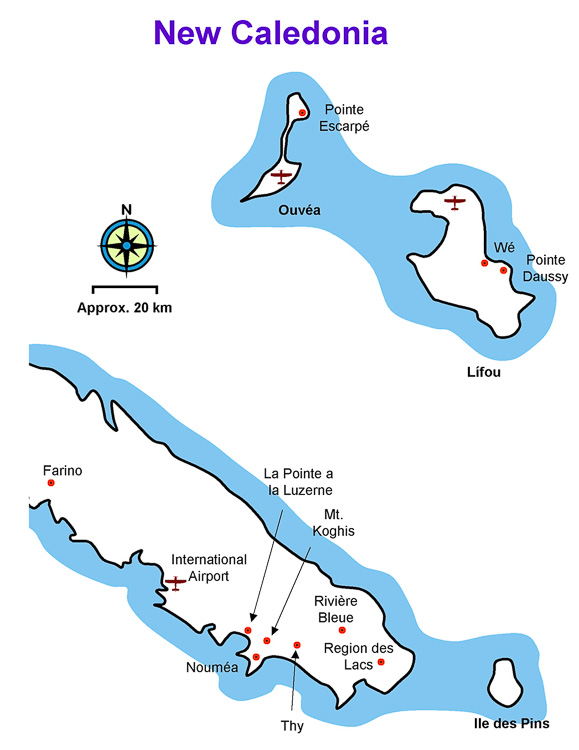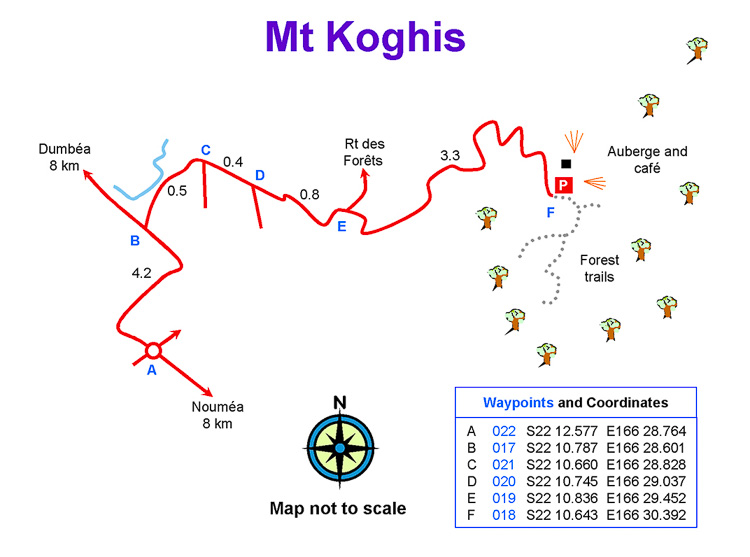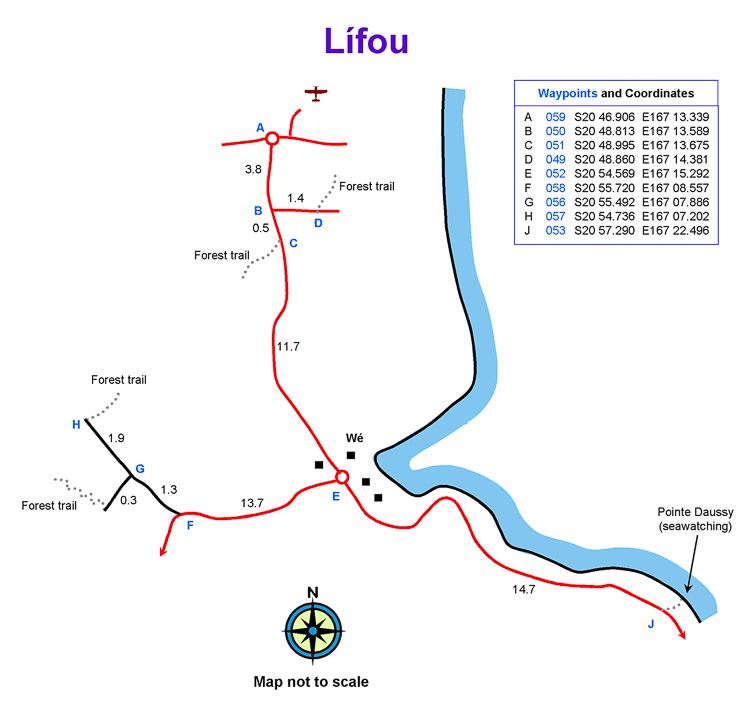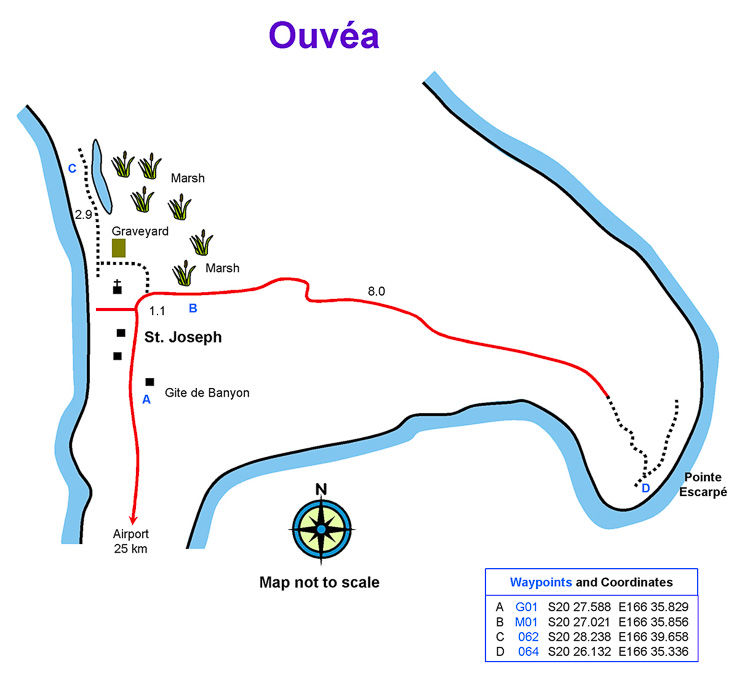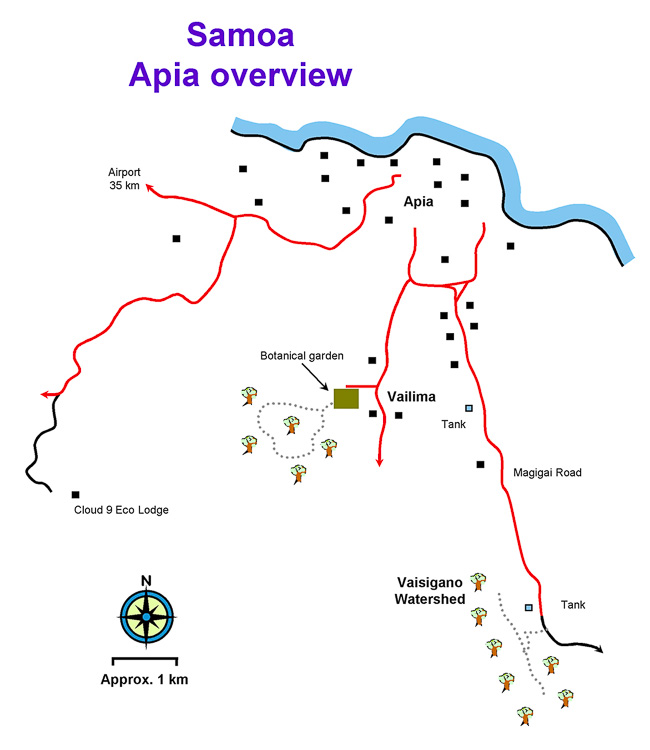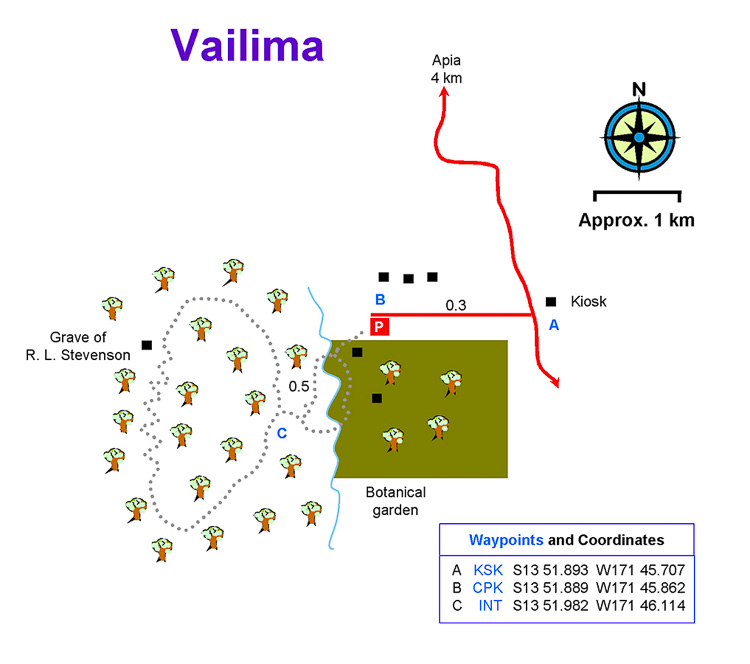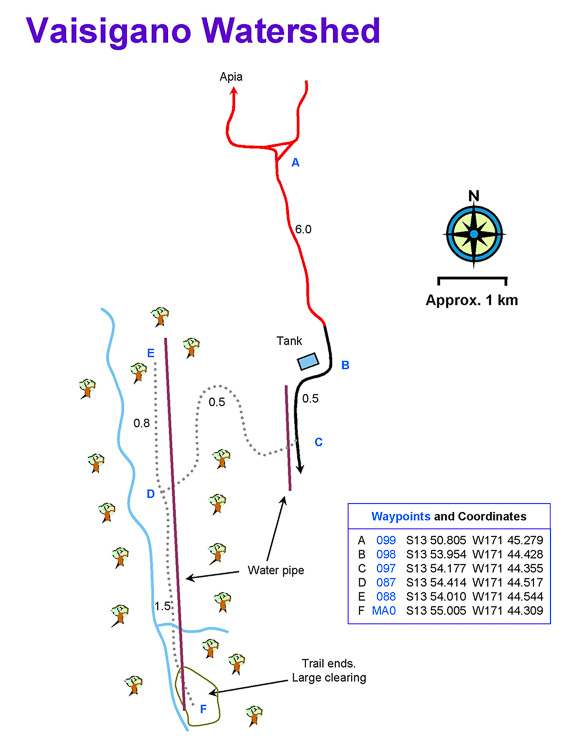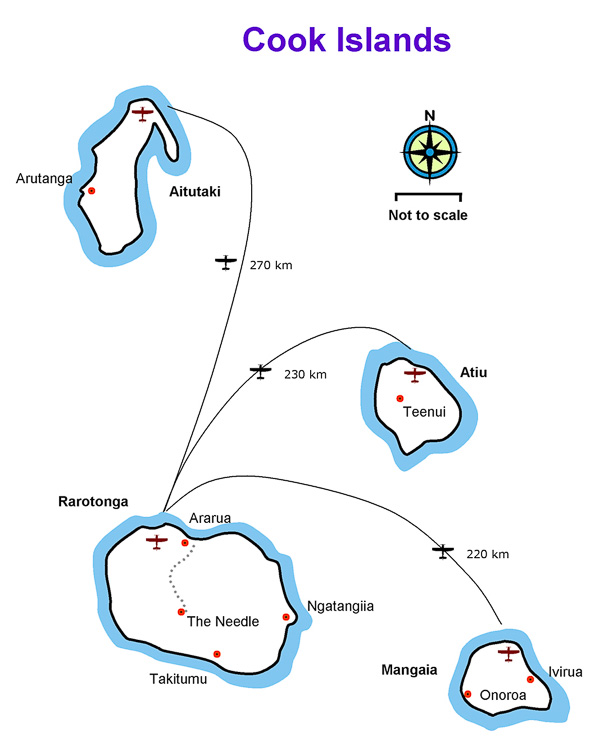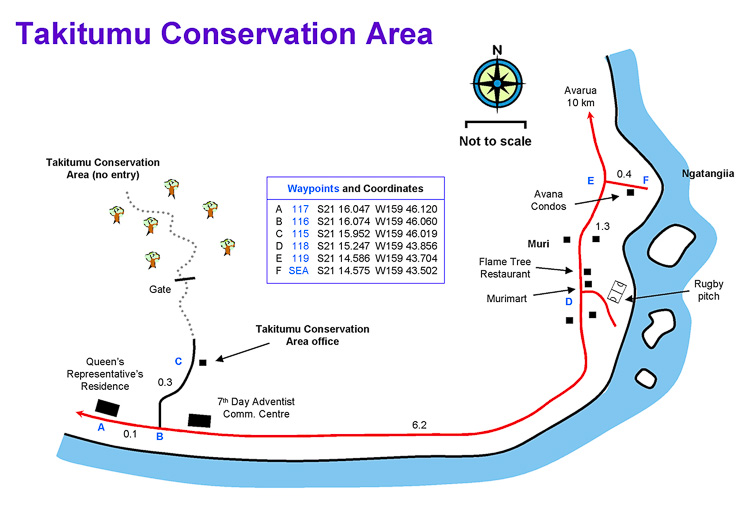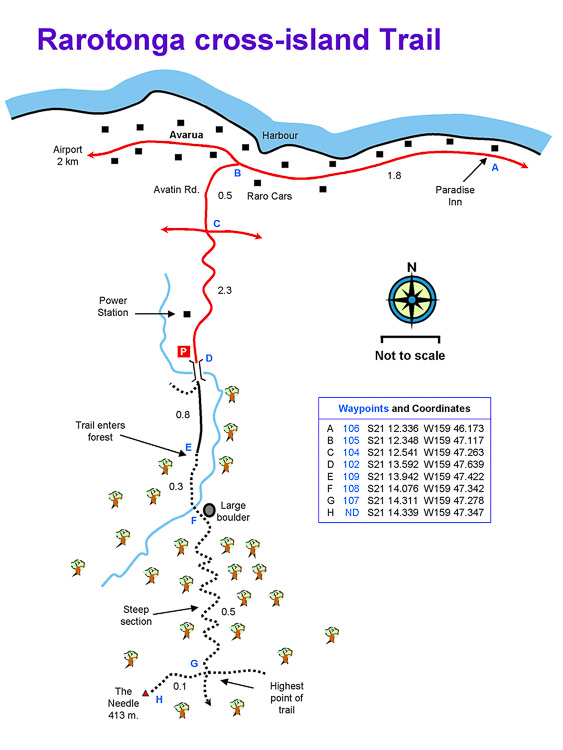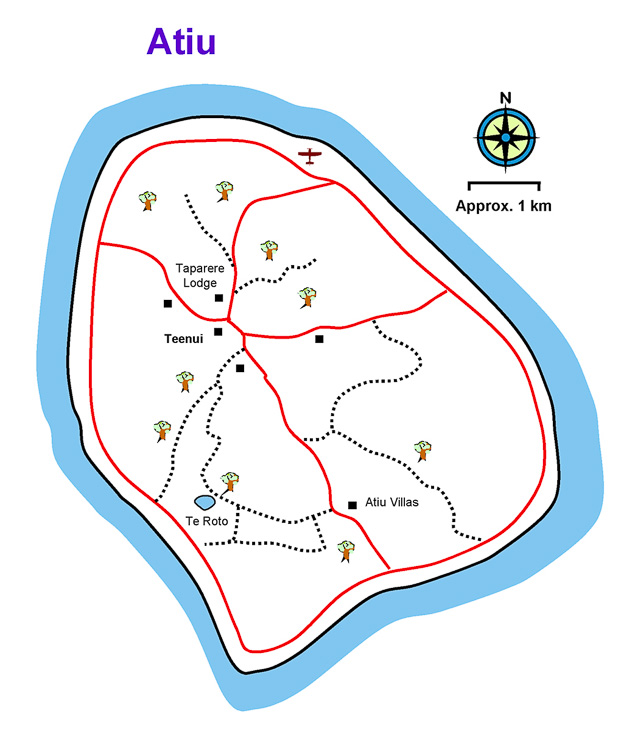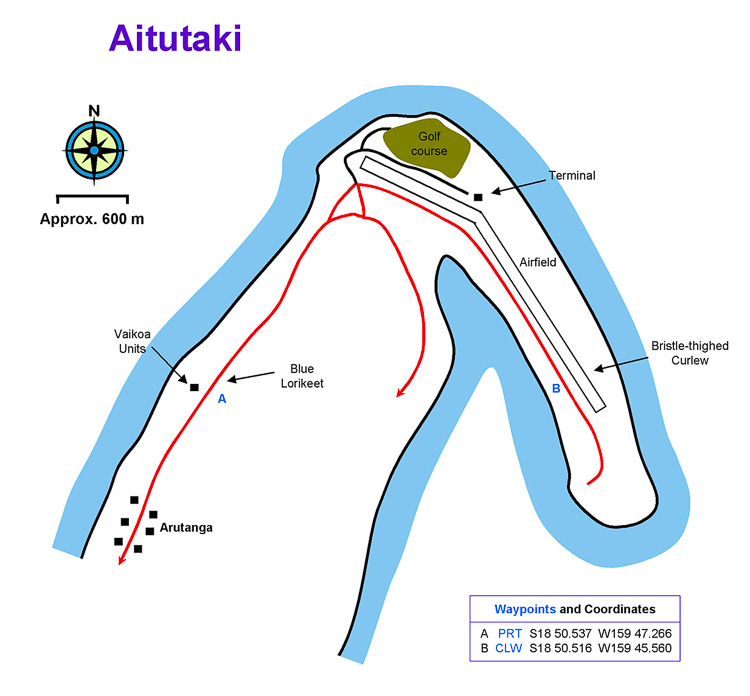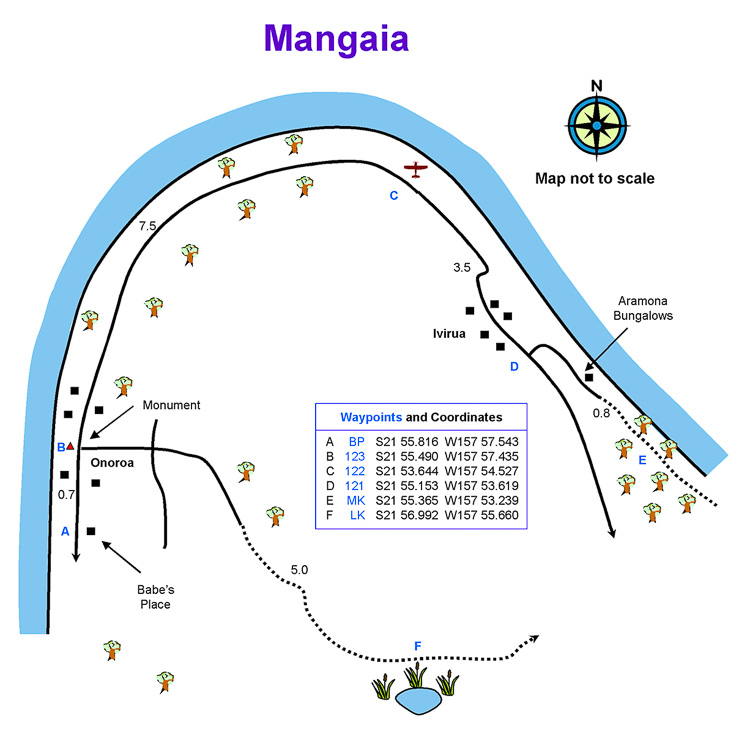Birding sites
This report is divided into three sections:
Section 1 - Introduction, logistics general information and itinerary.
Section 2 - Birding sites.
Section 3 - Systematic species list.
Details are provided for all sites visited. Most are accompanied with a map made in the field at the time. All maps have salient GPS waypoints included, which appear at the foot of this page.
New Caledonia
A week on New Caledonia should be ample time to get to grips with the endemics, and with luck a few days would suffice. A total of 20 endemics occur, plus an additional three (New Caledonian Rail, New Caledonian Lorikeet and New Caledonian Owlet-Nightjar) which are currently classified as extinct but still might occur is some remote areas.
The most difficult of the endemics to locate is the New Caledonian Grassbird which is scarce and skulking. Key to finding several of the rarer species is access to Rivière Bleue National Park, as Kagu and Crow Honeyeater are only likely to be seen there. Other, non endemic specialities include Red-bellied Fruit Dove and Cardinal Myzomela. |
|
Endemics
New Caledonian [Gould's] Petrel Pterodroma (leucoptera) caledonica
New Caledonian Goshawk Accipiter haplochrous
Kagu Rhynochetos jubatus
Cloven-feathered Dove Drepanoptila holosericea
New Caledonian Imperial Pigeon Ducula goliath
Horned Parakeet Eunymphicus cornutus
Ouvea Parakeet Eunymphicus (cornutus) uvaeensis
New Caledonian Parakeet Cyanoramphus (novaezelandiae) saissetti
New Caledonian Myzomela Myzomela caledonica
New Caledonian Friarbird Philemon diemenensis
Crow Honeyeater Gymnomyza aubryana
Barred Honeyeater Phylidonyris undulata
Yellow-bellied Robin Eopsaltria flaviventris
New Caledonian Crow Corvus moneduloides
New Caledonian Cuckooshrike Coracina analis
Striated Starling Aplonis striata
Large Lifou White-eye Zosterops inornatus
Green-backed White-eye Zosterops xanthochrous
Small Lifou White-eye Zosterops minutus
New Caledonian Grassbird Megalurulus mariei
1. Farino, New Caledonia
Farino has recently become the most popular (I wouldn’t say easiest!) site for finding New Caledonian Grassbird. Previously, birders looked for it at Mount Koghis, but it has become scarcer and more difficult to locate there in recent years. At Farino, we located a pair in rank grass about 300 metres down the track from the parking area at the top. The habitat at Farino contains some well forested slopes, and many of the other endemics occur. A few hours here will be very rewarding. The grassbird is said to favour Lantana, although both our observations (Farino and Le Thy) were in grass. Farino is located about 60 kilometres north of the international airport so, time-permitting it’s a good site to start with immediately upon arrival.
From the airport take the main highway (Route 1) northward through Boulouparis and La Foa. Shortly after La Foa take the right hand turning toward Farino and Sarraméa, turning left 1.2 km after having left the highway. From here follow the map, or signs to Refuge de Farino. Note that at the stream with the small bridge (F, near waypoint 010) the refuge is signposted on the paved road on the south side of the stream. However, this is not the road required to drive up the mountain, which is the unpaved road on the northern side. This track is easily drivable with a 4x4. Follow the track for 5.5 kilometres where it peaks at a pass with a parking area. Species of interest can occur in any habitat here, and the grassbird must be possible in any of the Lantana and rank grass. We explored the trail downhill through the old gate for around one kilometre, but it continued farther. Amongst others we found Cloven-feathered Dove (the only site we recorded this species), Barn Owl, New Caledonian Crow, New Caledonian Flycatcher, New Caledonian Whistler, New Caledonian Grassbird, and Red-throated Parrotfinch. Others have seen White-bellied Goshawk and Metallic Pigeon. A number of cabins and lodges can be found around La Foa and Farino. |
|
2. Mount Koghis, New Caledonia
Mount Koghis, about eight kilometres outside Nouméa, is accessed by paved road off the Nouméa to Dumbéa road. An auberge and café are situated at the summit from which good views over the surrounding forest can be had. A number of forest trails are available, and popular with weekend visitors and tourists.
|
The best strategy is to park at the café and simply stroll the main road. Scan the forest slopes for White-bellied Goshawk and Metallic Pigeon. Around the car parking area look for New Caledonian Myzomela, Horned Parakeet and Barred Honeyeater. Mount Koghis is supposedly a good spot for New Caledonian Crow, but we only recorded two. Likewise, New Caledonian Grassbird was formerly commoner here than elsewhere but is now hard to find.
3. Le Thy Park, New Caledonia
Few birders have visited this area, which lies just off the RP1 main road between Nouméa and Rivière Bleue. The turnoff is approximately 13 kilometres from Nouméa and 25 kilometres before Rivière Bleue. We tried this area in passing as we had a few hours to spare, and found the birding good.
|
Access is unrestricted, but in a later conversation with Jean-Marc Meriot at Rivière Bleue he said that local people sometimes take objection to outsiders wandering into the area. We didn’t find this an issue, and in trying to locate the track up the hill, asked several people directions without problems. The park proper is quite a distance into the mountains, but it’s possible to drive the access track and walk through forest and coffee shade forest. A 4x4 is required to get a decent way up this track. Having driven about three kilometres from the main road we walked for a further two or three kilometres finding New Caledonian Grassbird higher up. Coming from Nouméa, turn off the main road, 0.7 km after crossing the small Thy river (which is signed). The turning is just after a local football pitch. Continue strait for 0.9 km and take the left fork which soon turns to a dirt track. We managed to drive 2.3 kilometres from the fork, after which we parked and walked. |
4. Inter-island ferry, New Caledonia
Many interesting seabirds occur around New Caledonia, including the endemic caledonica form of Cook’s Petrel. The best way to observe many of these pelagics would be to take the inter-island ferry which runs between Nouméa, Ouvéa, Lífou and Isle de Pines. It is important not to take the route to Isle de Pines as this does not pass outside the coral reef surrounding the main island, so would not be expected to produce any numbers of petrels or shearwaters. The ferry schedules are announced two weeks in advance, and published in local papers. Each island is served once or twice a week. This makes making advance arrangements impossible.
5. Parc Provincial Rivière Bleue, New Caledonia
Ensuring a visit to Parc Provincial Rivière Bleue should be considered the priority for visiting birders. Realistically both the Kagu and Crow Honeyeater are unlikely to be seen elsewhere, and several other species are more easily seen here than elsewhere. Note that the park is closed on Mondays, but that it is no longer necessary to obtain a permit in advance from Nouméa. Entrance to the park costs FP 400 per person or FP 20,000 per day for a group with a guide.
Birders wishing to maximise their chance of seeing Kagu should consider using a guide. The famous Yves Letocart (Mr. Kagu) was the guide everyone contacted in the past, but as he is now retiring, Jean-Marc Meriot has become the principle contact for birders. Several trip reports mention problems with a collapsed bridge across the reservoir between the park HQ and the main forest of the park, necessitating a long drive around the lake to access the park, only permissible with a guide. The situation on the ground appears to have changed somewhat, and a causeway has been built just west of the old collapsed bridge. Whether this causeway will last a full wet season flood though is questionable. The collapsed bridge did not appear to be in a derelict state either, although only park staff were allowed to use it. At the time of our visit, anyone with a vehicle (4x4 preferably) was able to cross the causeway and gain access to the park. A vehicle here is necessary as the reserve is large and it's a fair way (10+ kilometres) from the entrance to the best birding areas.
The park is situated about 38 kilometres east of Nouméa, on the Nouméa - Yaté road. The route out of Nouméa can be found by following GPS waypoints A01, 023, 024, 025, and 026, where A01 is the starting point of the Yaté road, and 026 the entrance road to the park.
6. Lake District, New Caledonia
For those with time, two large freshwater lakes (Lac Grande and Lac en Huit) just east of La Capture, itself about 50 kilometres east of Nouméa, can be interesting to visit for ducks and migrants. Species we saw here but nowhere else in New Caledonia included Australasian Grebe and Hardhead. The roads in this area are graded but dirt, so a 4x4 would be advisable in the wet season.
7. Pointe de Luzerne, New Caledonia
We discovered these mudflats on our last morning whilst returning to the airport, and found them more productive for waders than all other areas around Nouméa. The turnoff from the main highway is unobtrusive and not actually signed as Pointe de Luzerne. The turnoff is located 29.3 kilometers from the international airport. Turn southward off the highway and continue to the end of the road (waypoint 066) and walk on the beach. In a half hour here we found a number of Grey-tailed Tattler, Pacific Golden Plover, Eurasian Whimbrel and Bar-tailed Godwit.
8. Lífou, New Caledonia
The island of Lífou has two single island endemics - Large Lífou White-eye and Small Lífou White-eye - plus a few regional specialities such as Cardinal Myzomela, Red-bellied Fruit Dove and Blue-faced Parrotfinch, although the later appears to be rare. Many birders visit Lífou on a half day trip, and certainly all the specialities may be found within walking distance of the airport. However, we found gaining good views of the Red-bellied Fruit Dove and Large Lífou White-eye difficult, and would have been struggling if we'd needed to return to the airport within a few hours. With more time we were able to explore more forested areas, as well as do some productive seawatching. By driving around, we found several good forest areas, which are marked on the map. Simply stopping anywhere with suitable habitat should produce the specialities. The Large Lífou White-eye is much less obvious than its smaller relative, but is fairly common once the voice is known.
|
Studying a map, we concluded that seawatching would be best along the east coast where the reef approaches the shore closest, but access we found to be very difficult. The limestone crags with heavy forest make access to the coastline almost impossible. We did however discover one access point at Pointe Daussy on the east coast, 14 kilometres southeast of Wé. It is necessary to hop over jagged rocks, so would not be recommended for those with any infirmity. It's also imperative to bring something rather thick to sit on – these rocks are savage. In two sessions we saw New Caledonia Petrel, Tahiti Petrel, and a good migration of Sooty Shearwater and Wedge-tailed Shearwater.
Access to Lífou is either via flights from Nouméa, or the weekly inter-island ferry (see above). Rental cars are available at the small airport on arrival, but it would be advisable to book in advance. Accommodation is available at several resorts, mainly around the town of Wé.
9. Ouvéa, New Caledonia
The primary reason to visit Ouvéa is to find Ouvea Parakeet, a recent split from Horned Parakeet. The population is evidently not large, and it is good to see conservation efforts in place in an attempt to educate local people. Additionally, nesting boxes have started to be placed. Although it might be possible to find the parakeet in searching suitable habitat, much of this is on private land. The simplest option is to arrange a visit with a local guide, which could be arranged simply by asking once on Ouvéa, but for those with limited time, could be a risky strategy.
|
We made arrangements through Arc en Ciel who lined-up Roland, with whom we stayed and who took us to some private land. In earlier discussions with Roland we'd tried to persuade him to search for the parakeet at first light, as we thought finding them might be tricky. Once in the right place however, seeing the parakeet was simplicity itself, as several were feeding on fruiting papaya immediately adjacent to the landowners shack, and fairly tame.
The area we were taken was only a few kilometres from Roland's gite in St. Joseph. Other species in this area included Fan-tailed Cuckoo, Shining Bronze Cuckoo, Emerald Dove and Red-bellied Fruit Dove. Those with time to spare can check the marsh located just north and east of the church. Be warned that the edges of this marsh although looking like firm sand have the consistency of custard, and one foot wrong and you'll be standing a metre deep in gooh – very nasty stuff. We found Brown Goshawk, and Pacific Black Duck in this area. The few waterbirds on the Ouvéa list must occasionally turn up here. With Ouvéa totally surrounded by coral reef, seawatching opportunities are limited. The nearest point at which the reef approaches the shore is at Pointe Escarpé, about eight kilometres east of St. Joseph, which offers one of the few sea-watching points from the island. In a couple of hours here we saw Tahiti Petrel, Wedge-tailed Shearwater, Sooty Shearwater, Blue-grey Noddy and Brown Noddy.
Vanuatu
Cleaning up on Vanuatu is difficult and time-consuming; habitat, logistics, and weather, combined with rare and elusive species, mean that at least two weeks and probably more would be required. The rarest species is the Mountain Starling with only one recent record in 1991. Other rarely observed species are Vanuatu Petrel, Royal Parrotfinch and Tanna Ground Dove. Even so, with four to six days it is possible to see the majority of the endemics providing both lowland and mountain forests are visited. The later requires trekking and overnight camping.
Conveniently, all Vanuatu's land endemics are located on the island of Espirito Santo, on which three main birding areas are of interest; Loru, Vatthe and Pic Santo. For those with more time it would be interesting to also visit the Bank Islands to the north of the archipelago where Royal Parrotfinch might be more common, or even explore parts of Efate, the main island. Both children and adults with catapults are a common site, with the principal target appearing to be birds, which appear to be hunted both for food and sport. Few birders have visited Vanuatu, so logistical and birding information is lacking or outdated.
Endemic species
Vanuatu [White-necked] Petrel Pterodroma (externa) occulta.
Vanuatu Scrubfowl Megapodius layardi.
Tanna Ground Dove Gallicolumba ferruginea.
Tanna Fruit Dove Ptilinopus tannensis.
Baker's Imperial-Pigeon Ducula bakeri.
Chestnut-bellied Kingfisher Todirhamphus farquhari.
New Hebrides Honeyeater Phylidonyris notabilis.
Buff-bellied Monarch Neolalage banksiana.
Mountain Starling Aplonis santovestris.
Yellow-fronted White-eye Zosterops flavifrons.
Royal Parrotfinch Erythrura regia.
10. Loru Conservation Area, Vanuatu
Loru Conservation Area is situated just over an hour's drive, about 35 kilometres, north of Luganville. The area is not formally protected, but appears to be an area preserved by agreement with the local community, and was originally declared in an effort to protect the Coconut Crab Birgus latro. A strip of lowland forest bordering the sea grows over rocky limestone crags. The understorey is quite dense in places. Most of the forest is low, though a few areas do have taller trees, which seem to be the favoured haunt of Chestnut-bellied Kingfisher. Although vocal, this kingfisher tends to sit high in the canopy for lengthy periods making searching for them a neck-breaking activity. The Vanuatu Scrubfowl is fairly common, at least by voice, where it prefers the crags with dense vegetation, making them difficult to pursue. Being shy they take off rapidly when disturbed. Other species in the area include Buff-bellied Monarch, Yellow-fronted White-eye, and Tanna Fruit Dove, although I failed to see the latter.
No facilities are available at Loru, so most visitors simply do a day trip from Luganville, bringing food and water. However, having made advance arrangements, I stayed at the house of my guide, War, with his family. This was convenient though note there is no running water or electricity in the village. I paid VT 1,500. Visiting Loru without a guide would be quite difficult, as even finding the forest once there is not straightforward. A small sign on the main road marks the turn-off point, but from there it's several kilometres through a maze of rough dirt tracks, navigable only by 4x4, to the better habitat.
11. Pic Santu, Vanuatu
If time permits visiting only one site in Vanuatu, then Pic Santo should be it. However, you should be in reasonable shape for the climb and be prepared to camp on the mountain. Having experienced Pic Santo in the wet I would very strongly recommend to all, to only climb the mountain in the dry season. Visits at the height of the wet season would be downright dangerous and access to Ipayato, the starting point for the trek, would likely be impossible.
Logistics for this trip should be set up in advance. For the actual trek, it is necessary to carry all food, and porters can be arranged from Ipayato. These cost VT 1,000 per day and will act as guides as well. Permission to climb the mountain will be required from the village chief, which could create an unexpected delay should you arrive when he's not at home. Ipayato, about 50 kilometres west of Luganville, can be accessed by 4x4 vehicles which, when dry, take about 1.5 hours. By starting early from Luganville it should be possible to trek up the mountain directly, otherwise it will be necessary to stay overnight at one of the local homes in Ipayato.
My porters told me the trek to the top takes about 13 hours in good weather for those in good physical condition. The trail was rather overgrown when I climbed, but should become easier in the dry season. The best birding strategy is to walk long and hard the first day with an aim of establishing a base camp from where day trips to the higher parts can be taken. The first few hours of the walk are through cow pastures, coconut plantations and cut-over forest. Thereafter it enters forested slopes with large clearings, before entering closed-canopy forest after about five hours of walking. Once at the forest, species such as Tanna Fruit Dove, Baker's Imperial Pigeon, and Vanuatu Scrubfowl are possible, and Chestnut-bellied Kingfisher can be heard. At mid elevations from 500-900 metres, Vanuatu Honeyeater and Palm Parakeet can be found, and higher up are the areas to search for Guadalcanal Thicketbird and Rufous-winged Starling. For those wishing to try for Mountain Starling it would be necessary to try for the summit. To my knowledge the last sighting was of a pair in 1991. All attempts since to relocate them have failed. However, the terrain is still wild, forested, and few birders attempt the trek.
A tent is required, and temperatures drop quickly at altitude, so bring at least a light pullover and a good sleeping bag. I wanted to save on weight so didn't bring a sleeping bag – borrowing a blanket instead - and was too cold. If the weather is dry it will be possible to cook in the forest, so ask the porters to bring a cooking pot. This can be used to boil water for tea as well as cook rice, of which the porters seem to consume copious quantities. As it was so wet on my trip we didn't plan on being able to cook, so didn't bring rice, but were saved by a supply of rice in the hunter's shack where we stayed. My two porters plus War consumed more than a kilo of rice between them each day, so take plenty.
12. Vatthe Conservation Area, Vanuatu
Vatthe Conservation is situated in the northeast of Espirito Santo at Manatas (also known as Big Bay). Birds are similar to Loru, but as it is possible to reach higher altitude (around 500 m.) so a few others should be possible including Baker's Imperial Pigeon, although other mountain species such as Palm Parakeet are not recorded. Tanna Ground Dove is a rare resident. I did not visit this site, as for those visiting Pic Santo combined with Loru a visit here would probably not provide any additional species. Vatthe has both accommodation and guides available. Accommodation costs VT 2,150 per night, including meals. Alternatively it is possible to camp for VT 1,000. Guides are VT 1,000 per day. A once-off conservation fee of VT 600 is payable. Transportation from Luganville is VT 7,000 each way. In theory it is possible, with a guide to walk from Vatthe, up to Mt. Tabwemasana and Pic Santo. However, it is a long and arduous trek (2-3 days each way); the trek up Pic Santo is easier from Ipayato.
Samoa
Samoa has nine extent endemics, most of which are relatively easy to see by visiting only two sites – both near Apia the capital. However, two species, Tooth-billed Pigeon and Samoan White-eye, require a lot more effort, and a longer stay. The Tooth-billed Pigeon has most recently been reported from Lalomanu in the southeast. The Samoan White-eye occurs in the highlands of Savai'i Island and can be searched for by trekking up from A'opo village on the northern side of island – a guide will be required from the village, and possibly camping on the mountain. Of the other endemics, the most difficult to find is the Mao. Inexplicably I missed the Samoan Triller, though others have always been successful.
|
Endemics
Tooth-billed Pigeon Didunculus strigirostris.
Flat-billed Kingfisher Todirhamphus recurvirostris.
Mao Gymnomyza samoensis.
Samoan Whistler Pachycephala flavifrons.
Samoan Fantail Rhipidura nebulosa.
Samoan Flycatcher Myiagra albiventris.
Samoan Triller Lalage sharpei.
Samoan Starling Aplonis atrifusca.
Samoan White-eye Zosterops samoensis.
13. Vailima, Samoa
Vailima is the small forested mountain four kilometres south of Apia at the summit of which lies the grave of Robert Louis Stevenson (author of the children's book Treasure Island). A loop trail runs from the botanical garden at the base, around and over the mountain, that can be walked in less than an hour – more so if birding. The trail is popular with locals who use it as an exercise route and for general recreation at the weekends.
|
The forest holds all the commoner endemics, plus Mao, although this species is probably easier to find at the Vaisigano watershed. Access is open at any time, but a small park HQ has a visitor book which you are asked to sign, and leave a small donation if entering the park during "normal" working hours. The trail is steeper on one side and quite slippery when wet. During my several visits here I climbed the mountain at least seven times, thereby seeing Stevenson's tomb six times more than the average tourist! From town it is easy to take a taxi to Vailima, and should cost about WST 8.
14. Vaisigano, Samoa
The Vaisigano watershed is the forested valley to the west of the Magigai road, slightly east of Vailima, and further south from town. Getting a taxi drop-off presents no problem, but might require several kilometres walk back to town, as the area has few houses or people using the road.
|
Other birding reports for this site correctly refer to a tank/ reservoir at the end of the road as a starting point. In reality there are however two tanks, and in error, on my first visit, I was directed to the first, lower tank, from where it is not possible to walk up the valley very far. Ensure that the taxi drives the full six kilometres out along Magigai Road to drop you at the upper water tank. From here, continue 500 metres and take the rough track to the right (west), and follow it for another half kilometre or so, down into the valley. From the valley floor it is possible to follow the pipeline both up and down the river for a kilometre or so, searching forest edge. Trails into forest of the steep-sided slopes seem not to exist, and would be hard-going if they did. The Mao was found in the cleared area at the southern end of pipeline. |
Red-headed Parrotfinch was also here. Others have seen all the commoner endemics in this valley, and it must surely be the best habitat close to Apia.
Cook Islamds
A relatively easy, if expensive, set of endemics, coupled with an excellent location, weather and infrastructure make the Cook Islands a good choice for a family trip as well as a providing some excellent birding. It is probably not possible to clean-up the endemics and specialities in less than a week as they are scattered across several islands, served with domestic flights that do not operate daily.
|
Endemics
Cook Islands Fruit-Dove Ptilinopus rarotongensis.
Atiu Swiftlet Collocalia sawtelli.
Mangaia Kingfisher Todirhamphus ruficollaris.
Rarotonga Monarch Pomarea dimidiata.
Rarotonga Starling Aplonis cinerascens.
Cook Islands Reed-Warbler Acrocephalus kerearako.
15. Takitumu Conservation Area, Rarotonga, Cook Islands
The Takitumu Conservation Area was set up as a project to help the critically endangered Rarotonga Monarch (Kakerori being the local name for this species). The project, very successful to date, now holds more than 200 birds in the wild. The threat is the introduced Black Rat Rattus rattus which has to be constantly controlled by poisoning.
|
Access is only permitted on guided visits, which are run Tuesday and Thursday afternoons given sufficient demand. No official fee is charged, so a donation for any visit is very important. The area also holds Rarotonga Starling and Cook Islands Fruit Dove. Previously the project had an office in Avarua town, but this has been moved to the south coast adjacent to the conservation area. Finding the conservation area is not straightforward and is deliberately not signposted off the highway (to discourage casual visitors). The project office is located on the south coast, up a short dirt track found 100 metres east of the Queen's Representative's residence (an obvious fancy mansion).
16. Seawatching, Rarotonga, Cook Islands
The main species of interest is Herald Petrel that is thought to breed in the higher mountains of Rarotonga. Wheatley mentions watching the mountains from the beach at Muri in the late afternoon, but this was unsuccessful for me. I spent considerable time seawatching from Ngatangiia just north of here, but saw very little. A good possibility to see this species might be to watch from The Needle on the cross-island trekking trail (see below). A single bird was seen flying inland, mid afternoon, on the northwest coast, by other birders I met when there. This species cannot however be that common, as staff at Takitumu mentioned they'd never seen it.
17. Cross-island Trail, Rarotonga, Cook Islands
|
The well-known cross-island trail starts just north of Avarua, where it climbs up to The Needle (a pinnacle of rock) then drops to the southern coast. The forested slopes hold Rarotonga Starling and Cook Islands Fruit Dove. The view from The Needle is excellent, so it's possible to scan forested slopes and if very lucky catch a glimpse of Herald Petrel which is assumed to breed high in the mountains. The trail is fairly steep but easy to follow. The climb to The Needle takes about 45 minutes to an hour. Much of the trail is comprised of a maze of tree roots which are extremely slippery when wet. The start of the trail can be found by following Avatin Road out from the centre of town for 2.8 kilometres to a parking area by the river. From here follow the graded track along the river for 1.1 kilometres at which point the trail starts at the forest edge. On the climb up, where possible, scan for Rarotonga Starling. I had several very close to the trail. Tropicbirds are sometimes found around The Needle itself. |
18. Atiu, Cook Islands
Atiu, pronounced atchoo (as in the sneeze), island is 230 kilometres northeast of Rarotonga and holds the endemic Cook Islands Fruit Dove and the single island endemic Atiu Swiftlet. The regional endemic, Chattering Kingfisher, also occurs. Being served by less than one flight per day, an overnight stay is required, but the birding is interesting enough to warrant this. The Atiu Swiftlet is fairly common over the hills on the interior of the island and local guides can take you to the nesting caves.
|
The Rarotonga Monarch has been introduced on Atiu, which is rat-free, and numbers are small but increasing. 'Birdman' George is a colourful local character who conducts natural history tours, and works on the monarch introduction. He can be contacted by asking any of the locals; everyone knows everyone else on this island! The species of interest appear to be widespread, so taking any track through forest is likely to be productive. I had the kingfisher near Teenui. The pond at Te Roto in the south is worth a quick look and holds Pacific Black Duck with regularity, as well as Spotless Crake which of course is almost impossible to see. Accommodation is available at a few lodges situated around the main village in the centre of the island.
19. Aitutaki, Cook Islands
Pronounced Ay-two-taki, this island is 270 kilometres north of Rarotonga. It is a popular day trip destination for tourists, so is served by up to three flights a day. The island has no endemic species, but two specialities make a day trip worthwhile.
|
Open areas of the airfield and the adjacent golf course are regular haunts of wintering Bristle-thighed Curlew which generally arrive from late September. During my visit the golf course was packed with players so it was not seen there. However, a group of eight were found at the southern end of the airstrip in one of the low dips which made them impossible to see while scanning from the terminal building. The other speciality of Aitutaki is the Blue Lorikeet, which was introduced to the island at the end of the 1800s, but is now fairly common, and can be looked for in fruit plantations. I found a couple of groups along the road to town opposite the Vaikoa Resort.
20. Mangaia, Cook Islands
Pronounced Mang-eye-er, this island is 220 kilometres east of Rarotonga. The island has two endemic species – Mangaia Kingfisher and Cook Islands Reed Warbler. The warbler is very common and widespread, and can even be found in scrub right next to the airfield terminal building. The kingfisher can however, be a little tricky to find as it is restricted to forest. Mangaia has plenty of forest, but access into it is the problem, as the understorey is comprised of limestone crags with dense vegetation – virtually impenetrable. Having no specific information on where to search for the kingfisher I tried many forested areas, and eventually found a good track through closed canopy forest just south of Ivirua.
|
Take the track along the beach after the Aramona Bungalows; a walk in the late afternoon produced at least four kingfishers. The kingfisher also occurs along the road from the airport to town which passes through abundant forest, and I heard one bird en route. Predation of nesting birds by the introduced Common Myna poses a threat, and staff at Takitumu mentioned that in future some control of mynas might be attempted. As flights to Mangaia are less than daily, an overnight stay is necessary. Mopeds and bicycles are available for rent.
GPS waypoints
| Name | Lat/Long hddd°mm.mmm' | |
| 6 | S21 37.305 E165 45.347 | |
| 7 | S21 37.675 E165 45.745 | |
| 8 | S21 37.810 E165 45.700 | |
| 9 | S21 38.857 E165 46.488 | |
| 10 | S21 39.692 E165 46.343 | |
| 11 | S21 39.983 E165 46.425 | |
| 12 | S21 40.060 E165 46.515 | |
| 13 | S21 40.970 E165 47.333 | |
| 14 | S21 41.070 E165 47.613 | |
| 15 | S21 41.681 E165 47.339 | |
| 17 | S22 10.787 E166 28.601 | |
| 18 | S22 10.643 E166 30.392 | |
| 19 | S22 10.836 E166 29.452 | |
| 20 | S22 10.745 E166 29.037 | |
| 21 | S22 10.660 E166 28.828 | |
| 22 | S22 12.577 E166 28.764 | |
| 23 | S22 13.620 E166 30.285 | |
| 24 | S22 14.239 E166 35.103 | |
| 25 | S22 14.349 E166 36.294 | |
| 26 | S22 10.141 E166 44.572 | |
| 28 | S22 11.046 E166 32.082 | |
| 29 | S22 12.277 E166 32.534 | |
| 30 | S22 13.371 E166 32.920 | |
| 31 | S22 13.458 E166 32.938 | |
| 32 | S22 13.826 E166 33.019 | |
| 33 | S22 13.933 E166 32.643 | |
| 49 | S20 48.860 E167 14.381 | |
| 50 | S20 48.813 E167 13.589 | |
| 51 | S20 48.995 E167 13.675 | |
| 52 | S20 54.569 E167 15.292 | |
| 53 | S20 57.290 E167 22.496 | |
| 56 | S20 55.492 E167 07.886 | |
| 57 | S20 54.736 E167 07.202 | |
| 58 | S20 55.720 E167 08.557 | |
| 59 | S20 46.906 E167 13.339 | |
| 66 | S22 10.968 E166 24.810 | |
| 87 | S13 54.414 W171 44.517 | |
| 88 | S13 54.010 W171 44.544 | |
| 97 | S13 54.177 W171 44.355 | |
| 98 | S13 53.954 W171 44.428 | |
| 99 | S13 50.805 W171 45.279 | |
| 102 | S21 13.592 W159 47.639 | |
| 104 | S21 12.541 W159 47.263 | |
| 105 | S21 12.348 W159 47.117 | |
| 106 | S21 12.336 W159 46.173 | |
| 107 | S21 14.311 W159 47.278 | |
| 108 | S21 14.076 W159 47.342 | |
| 115 | S21 15.952 W159 46.019 | |
| 116 | S21 16.074 W159 46.060 | |
| 117 | S21 16.047 W159 46.120 | |
| 118 | S21 15.247 W159 43.856 | |
| 119 | S21 14.586 W159 43.704 | |
| 121 | S21 55.153 W157 53.619 | |
| 122 | S21 53.644 W157 54.527 | |
| 123 | S21 55.490 W157 57.435 | |
| 125 | S22 13.768 E166 32.285 | |
| A01 | S22 13.551 E166 28.852 | |
| BP | S21 55.816 W157 57.543 | |
| CLW | S18 50.516 W159 45.560 | |
| CPK | S13 51.889 W171 45.862 | |
| GT | S22 11.454 E166 32.265 | |
| INT | S13 51.982 W171 46.114 | |
| KSK | S13 51.893 W171 45.707 | |
| LK | S21 56.992 W157 55.660 | |
| MA0 | S13 55.005 W171 44.309 | |
| MK | S21 55.365 W157 53.239 | |
| MN | S22 14.252 E166 32.170 | |
| ND | S21 14.339 W159 47.347 | |
| PRT | S18 50.537 W159 47.266 | |
| SEA | S21 14.575 W159 43.502 |
Section 1 - Introduction, logistics general information and itinerary.
Section 3 - Systematic species list.

